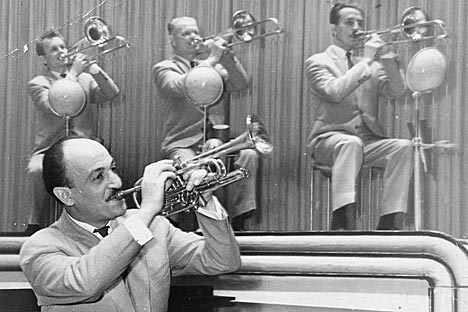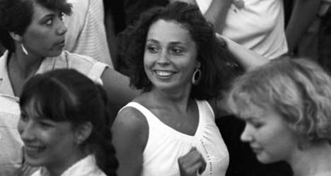New Russian jazz and its architects

Eddie Rosner. Source: Press Photo
During the 1960s, the most sophisticated Soviet intellectuals embraced the music of the avant-garde composers John Cage and Pierre Boulez, as well as the avant-garde jazz of Ornette Coleman and John Coltrane. Around this time, books were published about conceptual art and theatrical performances. These influences together engendered something original — new jazz.
The ideologue of new jazz was the journalist and music critic Efim Barban, who, in the mid-1970s, released the samizdatbook “Black Music, White Freedom.”
“Its first edition,” says Barban “was printed on an offset duplicator with 70 copies. The number is telling. In the mid-1970s in the USSR, less than 100 people were familiar with free [avant-garde] jazz. All these people knew each other, although geographically disparate—from Vilnius to Novosibirsk, and from Arkhangelsk to Almaty. Free jazz was part of the musical underground, part of alternative culture.”
Bringing new jazz to the West were Soviet emigrants from BBC Russian radio. Leo Feigin (pseudonym Alexey Leonidov) hosted a program on Soviet free jazz and released records by underground Soviet jazz artists under his own label, Leo Records. He was later to be joined by Efim Barban (pseudonym Gerald Wood) and Alexander Kan.
Among the icons of the genre was the trio “GTC”: Vyacheslav Ganelin (piano), Vladimir Tarasov (drums) and Vladimir Chekasin (vocals). They came together in Vilnius in the early 1970s. Their music stood apart for virtuosic improvisations in various styles.
I saw a concert by GTC in Moscow in the early ‘80s. Several hundred of the musical crowd typically attending underground rock concerts gathered at the cultural palace of the blind community. Back then, there was no separation between free jazz and rock, both being innovations enjoyed by students and intellectuals. The concert was held as part of “Jazz Subscription”—a sort of jazz awareness project where, over a year, various cultural palaces held jazz concerts, preceded by a talk from an official music scholar.
GTC – Poi Segue. Source: YouTube
GTC opened the way for a pantheon of musicians and represented the Soviet Union in the West as a country with its own jazz avant-garde. The Moscow journalist and musician Alexander Lipnitsky was the first in the Soviet Union to publish in the official newspaper “Soviet Culture” a positive article on the GTC trio, which cemented the status of the then obscure GTC and helped them survive in challenging Soviet realities.
A pithy expression was on everyone’s tongue: “Today he plays jazz, tomorrow he’ll sell the motherland!” A story emblematic of this regards Eddie Rosner, a widely popular musician and the first to play swing in the Soviet Union. In 1946, he was arrested by the NKVD and sentenced to 10 years in the Gulag, where he stayed until Stalin’s death in 1954. Any jazz musician could have shared Eddie’s fate.
Clip from the film “Eddie Rosner: Jazzman of the Gulag”. Source: YouTube
In 1948, the Politburo of the Central Committee of the Communist Party issued an odious directive stigmatizing the formalist musical movement as “alien to the people,” jazz artists included. The threat of the Gulag loomed over musicians playing “the wrong music”.
This period of Soviet jazz history has been called “the time of straightening up the saxophones.” The jazz saxophone was proclaimed an enemy of Soviet society.
In the 1970s, many leading musicians lacked professional status or were listed among the state philharmonics, which provided them neither concerts nor road tours. Melodia, the only Soviet recording company, released records by Soviet jazz artists only rarely. As a rule, these were compilations. Musicians waited years for solo records to be released, and some never were.
Due to repression, musicians emigrated to the West as soon as possible. By the early 1990s, dozens of talented jazz artists had fled the country to Israel, Germany, France and the U.S.
Another great innovator, besides GTC, was Sergey Kuriokhin (1954-1996). Initially a free-jazz pianist, he earned his greatest acclaim as the creator in 1984 of Pop-Mechanika (PM) — an avant-garde fusion of the most varied styles, from free-jazz, rock and variety, to theatrical absurd, plus happening and performance-art. Kuriokhin crafted his own directing techniques, including jumps and leg waves.
PM effectually and innovatively merged various, often disparate kinds of music and theatre. Its membership varied from several musicians to dozens. Animals were even brought onstage. Alumni of PM included musicians from Leningrad’s leading groups of the 1980s — Aquarium, Kino and Auction.
Many famous jazz musicians participated in PM, as well, including Vladimir Chekasin (GTC), Sergey Letov, Igor Butman, Arkady Shilkloper and more.
Pop-Mechanika (1985). Source: YouTube
Pop-Mechanika–Noah's Ark (Tsoi, Kasparyan, Butman, BG)
Sergey Kuriokhin – Pop-Mechanika № 418. Source: YouTube
Sergey Kuriokhin and Pop-Mechanika. Source: YouTube
Pop-Mechanika. Source: YouTube
The Sergey Kuriokhin International Festival is held every year in St. Petersburg. Also operating today is the Sergey Kuriokhin Modern Arts Center, which represents and supports young, experimental, avant-garde musical projects. However, no geniuses or innovators of the caliber of GTC and Kuriokhin have emerged; this is now history.
New jazz is a unique example of a vibrant musical phenomenon created by several talented enthusiasts at their own risk, defying the totalitarian system.
All rights reserved by Rossiyskaya Gazeta.
Subscribe
to our newsletter!
Get the week's best stories straight to your inbox
